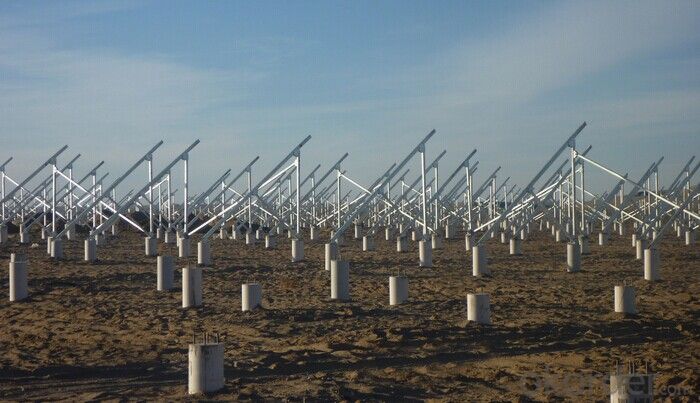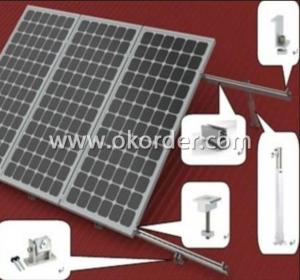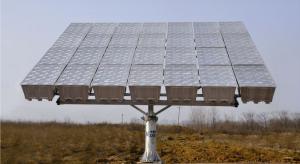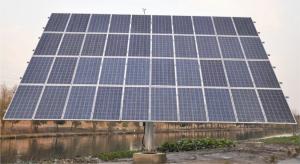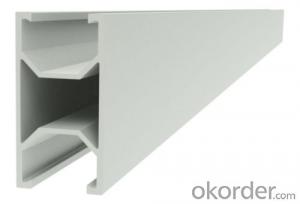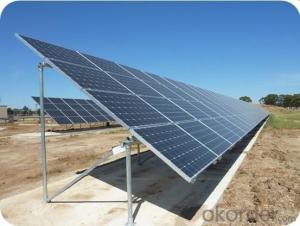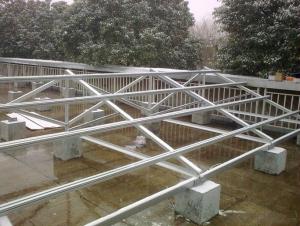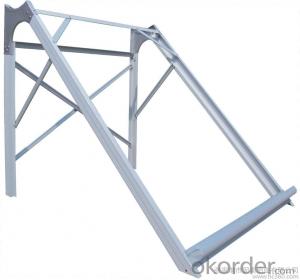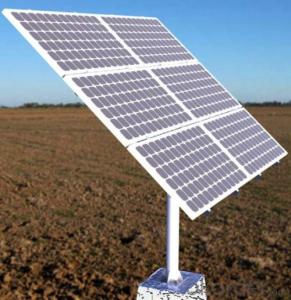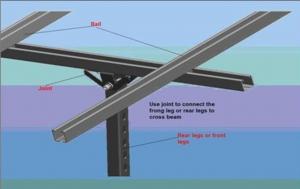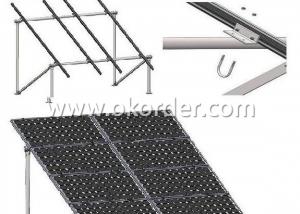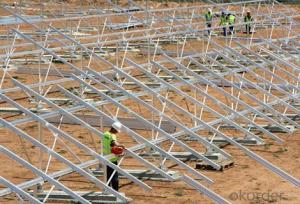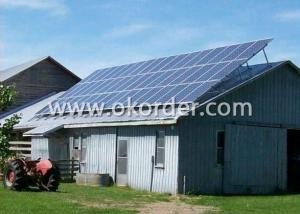Ballasted Solar Mounting Systems for Beach Solar Mounting Support System, Bracket
- Loading Port:
- Shanghai
- Payment Terms:
- TT OR LC
- Min Order Qty:
- 100000 watt
- Supply Capability:
- 50000000 watt/month
OKorder Service Pledge
OKorder Financial Service
You Might Also Like
Beach Solar Mounting Support System, Bracket
the performance featuresof the beach support system is that using the topography,free of support foundation-making.flat laid the supporet system,simple structure,lower cost. Rapid construction,beautiful appearance,could be used two times.
Product introduction:
HCPV dual-axis tracking system is high-tech petented product.
The tracker bracket adopt hot-dipped galvanizde high-quality structual steel Q235B,system stability is very high and maintenance cost is very low,working time more than 25years.
adopt pillar type structure,the bearing is free of oil and windproof.
the two axis both using slewing drive.
frame stucture with 5 supporting points.
power generating can increased more then 40%.
Features:
1. The system, which uses an isosceles triangle bracket as bracket structure and maintenance-free, wind and sand-proof high polymer material bearing moving parts and unique linkage structure, features reliable system stability, low cost and low failure rates.
2. Compared with traditional fixed-bracket its annual energy output can be increased up to approximately 20 percent - 30 percent.
3. With exactly the same or even lower cost as fixed-bracket the system is the optimal choice for the establishment of large and medium-sized high-efficiency solar power stations.
Specification:
| Installation site | Roof |
| Installation angle | customization |
| Wind resistance | 35m/s |
| Solar Panel Type | frame or frameless |
| Solar panel size | any size |
| Mount track | aluminum extrusion attachment |
| Mount materials | Q235B/6063-T5 |
| Installation height | customization |
| Snow load | 1.4KN/m2 |
| Components arrangement | laterally or longitudinally |
| International Standards | comply with AS/NZS 1170 and other international standards |
| Quality Warranty | 20 years |
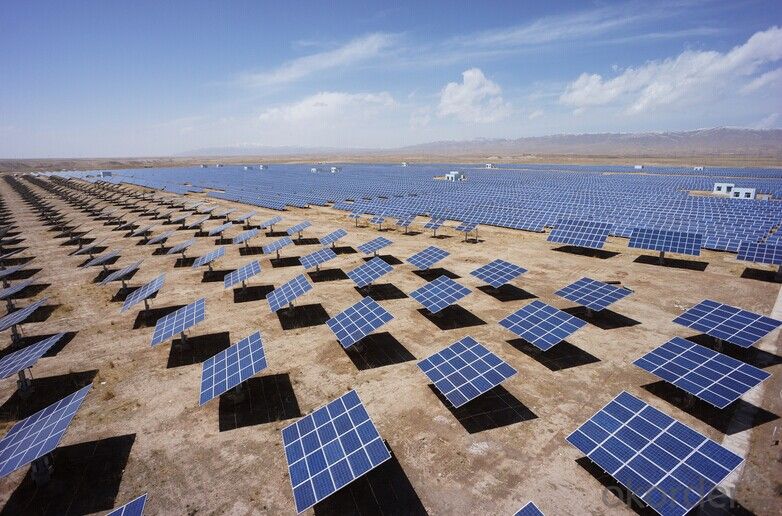
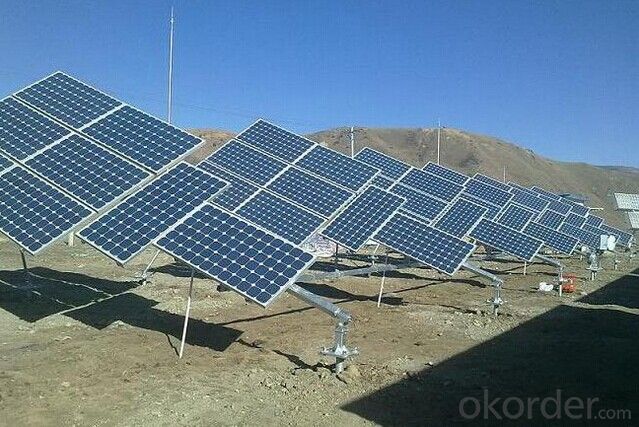
FAQ:
1. How long will my inquiry get response?
Your inquiry related to our products or prices will be replied within 24 hours.
2. Can I get professional service and suggestion?
Well-trained and experienced staffs to answer all your questions in fluent English.
3. Do you accept OEM or customized design?
OEM & ODM, any your customized lightings we can help you to design and put into product.
4. What if I need specific design?
Distributorship are offered for your unique design and some our current models.
- Q: Are there any specific requirements for charging station or EV infrastructure design when using a solar mounting system?
- Yes, there are specific requirements for charging station or EV infrastructure design when using a solar mounting system. These requirements include ensuring that the solar mounting system is properly sized and designed to support the weight and size of the charging station or EV infrastructure. Additionally, the design should consider the orientation and tilt of the solar panels to maximize solar energy generation. It is also important to ensure proper electrical wiring and grounding to safely connect the charging station or EV infrastructure to the solar system.
- Q: How does a solar mounting system work?
- A solar mounting system is designed to securely fasten solar panels to a roof or ground surface. It typically consists of rails or frames that are attached to the surface, onto which the solar panels are then mounted. The mounting system ensures the panels are positioned at an optimal angle to maximize sunlight exposure. It also provides stability and protection against wind, snow, and other weather elements. Additionally, the system may include wiring channels to hide and protect the electrical wiring connecting the panels to the inverter and electrical grid. Overall, a solar mounting system plays a crucial role in efficiently and safely installing solar panels, allowing them to effectively generate clean and renewable energy.
- Q: Are there any government incentives or rebates available for installing a solar mounting system?
- Yes, there are government incentives and rebates available for installing a solar mounting system. These incentives and rebates vary from country to country and even within different regions or states. It is advisable to check with local government agencies, utility companies, or solar industry associations to determine the specific incentives and rebates available in your area.
- Q: Can a solar mounting system be used in areas with limited access to solar research facilities?
- Yes, a solar mounting system can be used in areas with limited access to solar research facilities. Solar mounting systems are primarily designed for the installation of solar panels on rooftops, ground, or other surfaces to capture sunlight and convert it into electricity. While solar research facilities may provide additional resources for studying and optimizing solar energy, the basic installation and operation of a solar mounting system can be done without direct access to such facilities. The key requirement for using a solar mounting system is access to sunlight, which can be found in various locations regardless of the availability of research facilities.
- Q: Can a solar mounting system be installed on a boat or yacht?
- Yes, a solar mounting system can be installed on a boat or yacht.
- Q: What are the installation requirements for a solar mounting system?
- The installation requirements for a solar mounting system typically include a few key factors. First, the system should be installed on a structurally sound roof or ground surface that can support the weight and stress of the solar panels. This may involve a professional assessment of the structure's stability. Second, the mounting system should be positioned in an area that receives ample sunlight throughout the day, preferably free from obstructions such as trees or buildings that could create shading. Lastly, proper electrical wiring and grounding should be implemented to ensure the safe and efficient operation of the solar panels.
- Q: Are there any specific requirements for installing a solar mounting system on a rooftop with rooftop HVAC ducts?
- Yes, there are specific requirements for installing a solar mounting system on a rooftop with rooftop HVAC ducts. It is important to ensure that the solar panels do not obstruct or interfere with the HVAC ducts, as this can affect the performance and efficiency of the HVAC system. Additionally, proper clearance and spacing must be maintained between the solar panels and the ducts to allow for proper airflow and ventilation. It is recommended to consult with a professional solar installer who can assess the specific situation and provide guidance on the best installation approach to accommodate the rooftop HVAC ducts.
- Q: Can solar mounting systems be installed on flat roofs?
- Yes, solar mounting systems can be installed on flat roofs. There are specifically designed mounting systems available that can be used for flat roofs to securely install solar panels and maximize their efficiency.
- Q: Are there any specific requirements for awning or sunshade design when using a solar mounting system?
- Yes, when using a solar mounting system, there are specific requirements for awning or sunshade design. These requirements primarily focus on ensuring that the awning or sunshade does not obstruct or shade the solar panels, as it can significantly impact their efficiency and energy production. The design should allow for unobstructed sunlight to reach the panels throughout the day. Additionally, the awning or sunshade should be structurally sound and securely mounted to withstand any wind or weather conditions without posing a risk to the solar panels or the surrounding area.
- Q: Are there any specific considerations for installing a solar mounting system in a seismic zone?
- Yes, there are specific considerations for installing a solar mounting system in a seismic zone. Seismic zones are prone to earthquakes, which can put additional stress on the solar panels and mounting structures. Therefore, it is important to ensure that the mounting system is designed and engineered to withstand seismic activity. This may include using reinforced materials, proper anchoring techniques, and conducting a thorough structural analysis to ensure the system can withstand the forces generated during an earthquake. Additionally, local building codes and regulations for seismic zones must be followed to ensure compliance and safety.
Send your message to us
Ballasted Solar Mounting Systems for Beach Solar Mounting Support System, Bracket
- Loading Port:
- Shanghai
- Payment Terms:
- TT OR LC
- Min Order Qty:
- 100000 watt
- Supply Capability:
- 50000000 watt/month
OKorder Service Pledge
OKorder Financial Service
Similar products
Hot products
Hot Searches
Related keywords





